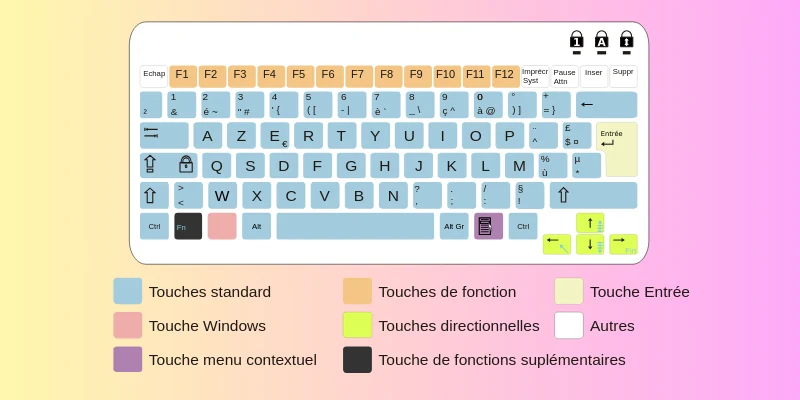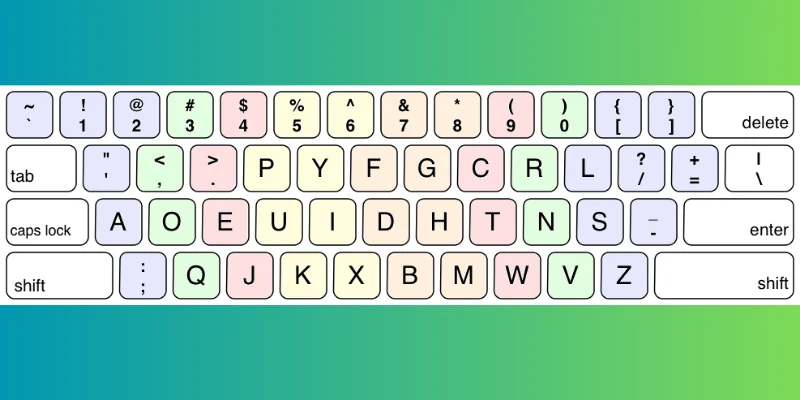Azerty vs Dvorak layout changes how you write
Published: 22 May 2025
When it comes to Keyboard layouts, the comparison b/w Azerty vs Dvorak Layout reveals two fundamentally different approaches to typing. Azerty, widely used in French-speaking countries, is designed to accommodate the unique needs of the French language, while Dvorak was created to increase typing efficiency and reduce finger strain, primarily for English typists. Understanding the differences between these two layouts can help users choose the one that best fits their language and ergonomic preferences.
In this post, we’ll dive deep into the origins, design principles, pros and cons, and practical applications of Azerty and Dvorak. By the end, you’ll have a clear understanding of which keyboard layout might be right for you, whether you’re a French speaker, a typing enthusiast, or just curious.
What is the Azerty Keyboard Layout?
The Azerty layout was developed in the late 19th century, adapting the QWERTY layout to better fit the French language’s unique needs. The name “Azerty” comes from the sequence of letters on the top row of the keyboard: A-Z-E-R-T-Y.
While QWERTY was originally designed to prevent typewriter jams by spacing common letter pairs apart, Azerty aimed to optimize typing for French speakers by repositioning keys to make accented characters and punctuation marks more accessible. French contains many accented letters like é, è, à, ù, ç, and having direct or easy access to these is essential for smooth typing.

1. Key Characteristics of Azerty
- Accent Accessibility: Many accented characters are accessible without needing to use complicated key combinations or software tweaks.
- Punctuation Placement: French-specific punctuation, such as guillemets (« ») and the accented “ç,” have their own keys or shortcuts.
- Similar but Different from QWERTY: Many letters stay in familiar spots (making it easier for those familiar with QWERTY to adapt), but some keys like A and Q, Z and W are swapped.
- Regional Variants: Different French-speaking regions sometimes use slight variations of Azerty, reflecting local needs.
| Advantages of Azerty |
|---|
|
| Drawbacks of Azerty |
|---|
|
What is the Dvorak Keyboard Layout?
The Dvorak Simplified Keyboard was developed in the 1930s by Dr. August Dvorak and his brother-in-law, Dr. William Dealey. Dissatisfied with QWERTY’s inefficiencies, they set out to create a layout that would reduce finger movement and increase typing speed.
The Dvorak layout rearranges keys based on letter frequency and ergonomic principles:
- The most common letters are placed on the home row where fingers rest.
- Alternation between hands is maximized to reduce fatigue.
- Common letter pairs are positioned to promote fluid typing.
Dvorak was created as an alternative to QWERTY, with the goal of making typing faster, more comfortable, and less prone to repetitive strain injuries.

1. Key Characteristics of Dvorak
- Home Row Focus: Approximately 70% of typing is done on the home row, compared to only about 32% in QWERTY.
- Optimized for English: Designed specifically around English letter frequency and common digraphs.
- Completely Different Layout: Letters are arranged very differently, which means there’s a significant learning curve.
- Minimal Use of Pinky Fingers: Pinkies are used less frequently compared to QWERTY or Azerty.
| Advantages of Dvorak |
|---|
|
| Drawbacks of Dvorak |
|---|
|
Comparing Azerty and Dvorak in Detail
| Aspect | Azerty | Dvorak |
|---|---|---|
| Purpose | Optimize typing for the French language | Increase typing speed and ergonomics for English |
| Origin | 19th-century adaptation of QWERTY for French | 1930s redesign by Dr. August Dvorak |
| Primary Use | French-speaking countries (France, Belgium) | English-speaking users seeking efficiency |
| Key Layout | Similar to QWERTY with swaps (A/Q, Z/W) and accented keys | Completely different from QWERTY and Azerty |
| Typing Efficiency | Efficient for French, less so for English | More efficient for English, less ideal for French |
| Ergonomics | Moderate; based on QWERTY legacy | High; minimizes finger movement and strain |
| Learning Curve | Moderate for QWERTY users | High; requires relearning key positions |
| Language Support | French with accents and punctuation | Primarily English; other languages less supported |
| Hardware Availability | Standard on French keyboards | Usually requires manual software setup |
| Software Compatibility | Good for French, sometimes needs manual switching | Variable; some shortcuts and games problematic |
| Popularity | Widely used in French-speaking countries | Used by niche groups and typing enthusiasts |
Efficiency and Ergonomics: How Do They Stack Up?
1. Azerty’s Efficiency
Azerty’s design serves French typists well by placing accented vowels and frequently used punctuation within easy reach. However, the layout inherits many inefficiencies from QWERTY, such as less optimal letter placement for typing speed or ergonomics. For example, certain common French letters are placed on the top row, which requires finger stretching.
Typing in French is faster on Azerty than on QWERTY, but if you switch to English, the inefficiency becomes apparent because the layout doesn’t align with English letter frequency.
2. Dvorak’s Efficiency
Dvorak’s biggest strength is its scientific approach to letter placement. By putting the most common letters on the home row and balancing the workload between hands, it significantly reduces finger travel distance.
Studies have shown that Dvorak can reduce finger movement by up to 50% compared to QWERTY, which translates to less fatigue and potentially higher typing speeds. Alternating hands improves rhythm and flow.
That said, the actual speed gains depend on the user’s dedication to learning the layout, as muscle memory built around QWERTY or Azerty can be hard to overcome.
Language Support and Practicality
1. Azerty for French Speakers
Because Azerty is the official standard in France and Belgium, it’s fully supported by hardware manufacturers and software developers targeting these markets. The layout makes typing French accents and punctuation intuitive, which is crucial given the complexity of the French language.
For users who type mostly French, Azerty is a practical choice, ensuring compatibility and ease of use.
2. Dvorak for English (and Others)
Dvorak was designed with English in mind, so it aligns well with English letter frequency. This makes it less suited for French, which relies heavily on accented vowels and different letter distributions.
Dvorak is also less commonly supported by default on operating systems, requiring manual keyboard configuration. For bilingual or multilingual typists, switching between layouts can be cumbersome.
Learning Curve and Transition
Switching keyboard layouts is no trivial matter. The amount of time and effort to retrain your fingers can be a major deterrent.
- Azerty: If you already know QWERTY, learning Azerty is easier since many keys remain in similar positions. The biggest challenge is adapting to swapped keys (like A and Q) and accessing accented letters.
- Dvorak: Switching from QWERTY to Dvorak involves relearning nearly every key position. This can take weeks or even months to reach proficiency. The benefit, however, is long-term ergonomic and speed gains.
For professional typists or programmers, investing in learning Dvorak can pay off, but for casual users, it might not be worth the effort.
Community and Support
- Azerty enjoys official backing in French-speaking regions, with most local software and hardware supporting it natively.
- Dvorak has passionate advocates and communities online who share tips, tools, and resources for learning and troubleshooting, but it lacks official institutional support.
Azerty is designed primarily for French typing, making accented letters and punctuation easier to access. Dvorak focuses on typing efficiency and ergonomics, especially for English users, by minimizing finger movement. So, Azerty suits language needs, while Dvorak suits speed and comfort.
Yes, most operating systems allow you to switch keyboard layouts in the settings. You might need to add the layout manually and select it when typing. However, switching layouts means relearning key positions, so expect a short adjustment period.
If you type mostly in French, Azerty is easier to learn because it’s standard in French-speaking countries. For English typists interested in ergonomics, Dvorak can be better but has a steeper learning curve. Beginners should choose based on their main language and typing goals.
Many users find that Dvorak reduces finger movement and can improve typing speed after they’ve adapted to it. However, the speed benefit depends on consistent practice and commitment to learning the new layout. It’s not an instant fix but can be effective long-term.
Yes, switching frequently between different layouts can be confusing because key placements vary greatly. It’s best to stick with one layout for a while to build muscle memory. If you need both, consider setting up hotkeys to toggle layouts quickly.
Azerty can be used for other languages but isn’t optimized for them, especially English. The placement of keys like A, Q, Z, and W can feel awkward for English typing. For non-French languages, layouts like QWERTY or Dvorak might be better.
Because Dvorak minimizes finger movement and balances hand usage, many users report less fatigue and strain. It’s designed to be ergonomic, which can help prevent repetitive strain injuries. Still, proper typing posture is equally important.
Physical keyboards with Dvorak key labels are rare. Most users who switch to Dvorak use standard QWERTY keyboards and rely on software to remap the keys. You can buy keyboard stickers or custom keycaps if you want labeled keys.
Learning Dvorak can take several weeks to a few months depending on how much you practice. Daily consistent practice helps speed up adaptation. Expect an initial slowdown in typing speed before you improve.
Azerty is common mainly in French-speaking countries like France and Belgium. Dvorak is much less common globally but has a small dedicated user base among typing enthusiasts. QWERTY remains the dominant layout worldwide.
Conclusion
So guys, in this article, we’ve covered Comparison b/w Azerty vs Dvorak Layout in detail. Personally, if you primarily type in French or work within French-speaking environments, I recommend sticking with Azerty for its convenience and language support. However, if you’re looking to boost your typing speed and reduce fatigue while typing in English, giving Dvorak a try could be a game-changer. Which layout do you find most interesting? Share your thoughts and experiences in the comments below!

- Be Respectful
- Stay Relevant
- Stay Positive
- True Feedback
- Encourage Discussion
- Avoid Spamming
- No Fake News
- Don't Copy-Paste
- No Personal Attacks

- Be Respectful
- Stay Relevant
- Stay Positive
- True Feedback
- Encourage Discussion
- Avoid Spamming
- No Fake News
- Don't Copy-Paste
- No Personal Attacks
